I know you’ve probably been told that a good pitch deck and business plan are essential in the world of startups. It’s true — they are — but there is a LOT of conflicting advice out there on how to create them. (Hint: There isn’t just one right way.) I want to share some ideas based on solid research and real-world experience so you can create something that works for you.
In this article, I’ll discuss what a pitch deck is, explain its purpose and its importance in the outreach process, give you tips and practices to create your perfect pitch deck, and what to include in it. We’ll also look at an example of a pitch deck template, using slides from startups that have raised hundreds of millions from VCs. We’ll also explore why you must build a financial model alongside your pitch deck.
Before we get started, remember that pitching on stage and building your pitch deck are two very different things. Pitching is a form of art. Anyone can present a business plan or startup idea to another person, but only a few pitches are memorable and truly capture the interest of investors.
Practice makes perfect, and the better you get at pitching, the more likely you are to succeed. So sign up to pitch competitions, put yourself out there, and get feedback. The more you pitch, the better you will become at it. It’s better to make mistakes when it doesn’t matter than pitch unprepared to critical investors and risk disaster.
Now let’s dive into what it takes to build a great pitch deck!
Pitch Deck
Pitch decks are an essential document for every founder to master, but there is a lot of conflicting information out there, and no one-size-fits-all template.
To help you get started, we’ve pulled together pitch deck examples and best practices for new founders and early-stage startups.
Using this information to guide you, you’ll be able to create a pitch that will wow investors and get you the funding that your business needs.
What is a pitch deck?
A pitch deck is a condensed business plan that communicates your business idea to investors or partners. It should be clear, concise, and well-organised so that it promotes a conversation, not just information that needs to be digested. The pitch deck is used as an elevator pitch during your outreach process and should highlight the key aspects of your startup in a way that gets investors excited about working with you.
The pitch deck itself isn’t going to fund or run your startup — it’s just one piece of the puzzle — but it’s an important one. As Guy Kawasaki, Chief Evangelist at Canva, former Chief Evangelist at Apple, and author of The Art of the Start puts it.
The purpose of a pitch is to stimulate interest, not to close a deal.
While the pitch deck is an information-packed overview of your startup, it should be more than just numbers and figures. A winning pitch deck also captures the imagination by telling a story and getting the audience emotionally involved. People don’t buy products, they buy stories — pitch decks help people to see your startup as a compelling narrative instead of just an idea on paper.
What is its purpose?
A pitch deck helps you generate interest from investors so that they will fund or work with your company in some way. It is a way to quickly pitch your business idea and get feedback, without having to go through the entire business plan. The pitch deck should be used as a tool to start a conversation with potential investors so that you can get their feedback and determine if they are interested in what you’re doing.
Do you need a pitch deck and a business plan?
For an early-stage startup, the pitch deck and financial model are the business plan. There are too many uncertainties to waste time writing a 100-page business plan. Founders should use tools like the Lean Canvas to help them think through the different aspects of their business, but a pitch deck and financial model are essential when trying to raise money and get investment.
Who should create the pitch deck?
The pitch deck should be created by the founder or co-founder of the company. They are the ones who know the most about their business and can best pitch it to investors. Remember, the pitch deck isn’t what wins you the investment, but it will start the conversation and get people interested in what you’re doing.
How do you create a pitch deck?
There is no one-size-fits-all answer for this question, as the pitch deck needs to be tailored to your specific startup and its investors. However, there are some best practices that you can use to make sure your pitch deck is as compelling as possible.
Financial Model
The pitch deck should always include a financial model, typically as a supporting document, that shows financial projections for the next three to five years. This will help investors understand how you will manage the financial risks associated with your startup.
What is a financial model?
A financial model is a document that shows how your business will make money and what kind of return investors can expect on their investment. It includes projected revenue, expenses, and profits over a specific period of time.
Investors will expect to see a three to five-year financial forecast, broken down by year and month.
The financial model should also include a section on the startup’s burn rate – how much money the company is spending each month and how long it can continue to do so before running out of funds.
What is a financial forecast?
A financial forecast is a projection of future income, expenses, and profits. It typically covers a period of three to five years and breaks down revenue, expenses, and net cash flow by month.
How accurate does a startup financial model need to be?
The financial model doesn’t need to be complex, but it should show a realistic understanding of the numbers behind your startup.
It is important to remember that venture capitalists and angel investors do not expect your financial forecasts to be 100% accurate – they simply want to see that you have put thought into your business, that your operational plans are accounted for, and that you understand the basics of financial forecasting.
Pitch Deck Structure
As a founder, you’ll quickly learn that you’ll need more than one pitch deck. Different pitch decks are used for different purposes, and you may end up using a pitch deck that is specific to your target investor, the stage of investment, or the format in which you’ll be pitching.
This means that there is no magic formula for your pitch deck structure. However, there are a few essential slides that should be in every business pitch deck.
- Title or cover slide
- Problem
- Solution
- Market size and opportunity
- Team
- Ask
These slides will give the pitch deck a good structure and focus on the key elements that you want to talk about. There may be more slides depending on your company, but those are the main ones that should always appear somewhere in every pitch deck.
What to include in an early-stage pitch deck
Early-stage startup pitch decks are used to spark interest in your idea and the founding team. Venture capital firms and angel investors will be comfortable with greater uncertainty and higher risk in this pitch deck, so there is more leeway to experiment with different ideas and concepts. This doesn’t mean that you should just throw in everything without a thought though!
At this early stage, there will be multiple unknowns that you are setting out to solve, including exactly how you’ll build your solution to the problem, how you’ll find your scaleable route to market, and maybe even how you’ll convert users to paying customers.
It’s normal to not have all the answers to these questions, and that’s OK! It doesn’t mean that you should pitch an idea if you don’t know how it will work yet. All of this is just a reality check for potential investors — they need to see that you have a realistic idea of what you need to do and a plan for how you might do it.
What should I avoid putting into my pitch deck?
It’s a common mistake for first-time founders to try to put too much information into their pitch decks. This can include everything from detailed financial models to a full history of the company’s founding story. While it’s important to have all this information ready, it’s best to save it for when you’re actually speaking with investors.
Your pitch deck should be focused on your idea and the current state of your company. It should be set up in a way that clearly lays out who you are, what problem you’re solving, and how you plan to solve it. You want investors to see the actual value in investing in your startup so avoid including anything that’s not absolutely necessary for them to understand this concept.
– Do not include unnecessary information or graphics
– Keep your pitch deck to a maximum of 20 slides
– Stick to clear and concise language
– Make sure all the data is accurate and up to date
Be cautious about adding in anything that doesn’t support your pitch deck theme or the key points you want to make. If it isn’t relevant, remove it! You don’t have time for extra fluff when pitching investors; be direct and focus on what matters most.
Early-Stage Pitch Deck Example
The following pitch deck template is a good example of how you can tell a story that builds investor confidence in your startup idea. Using this format will set a great first impression and can help you with raising capital.
Slide #0 – Title
This is the most important slide in the whole deck, you need to grab the attention of the investor with a title slide that convinces them to keep reading. Your title slide must:
- Showcase your logo and brand name.
- In one phrase, state your value proposition.
- Engage the reader by promising them an interesting pitch.
It’s important to make your startup feel credible and trustworthy. Just as people will judge a book by the cover, investors will judge your pitch deck in less than five seconds, so make sure you have a strong first impression!
A common mistake that founders make with the title slide is not making the most of the opportunity. Taking inspiration from other industries, a prize-winning sticker on a book cover or a wine bottle has a tremendous impact on sales. What can you do to make your pitch deck stand out?
Examples


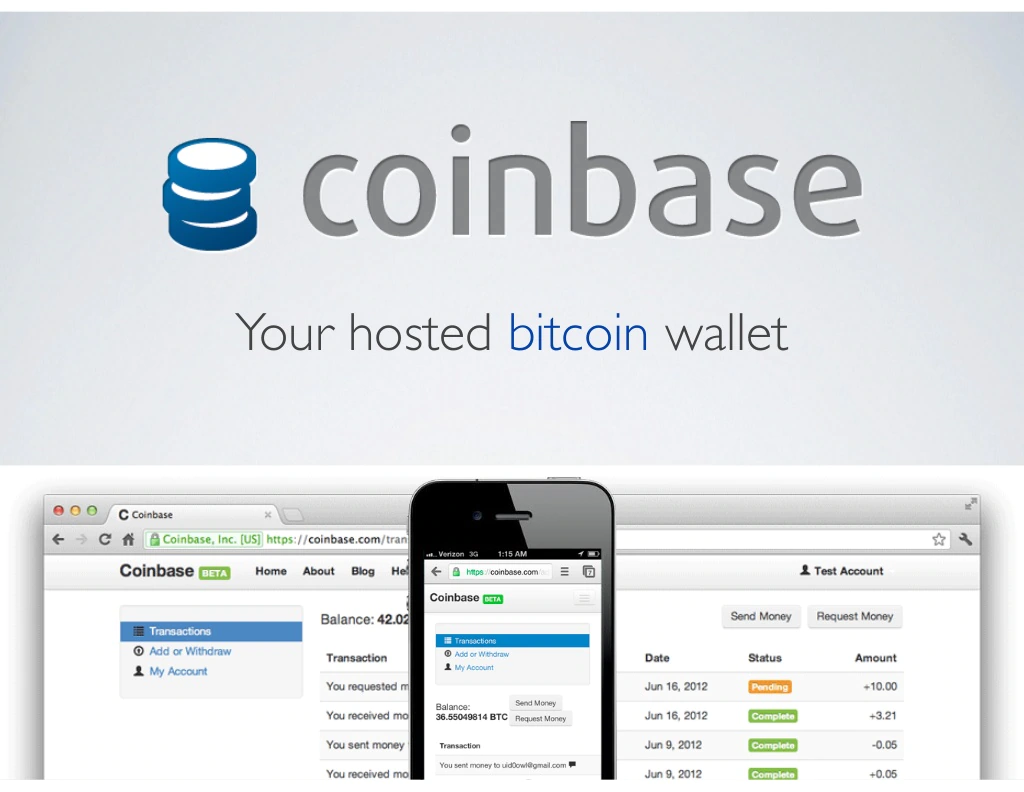

Slide #1 – Executive Summary
After catching your audience’s attention, you should include a company summary on slide one. Investors are unlikely to know anything about you or your company, so this is where you need to tell them what you do, where you’re going, and why they should care.
In just a few sentences, you should be able to concisely state the following:
- What your company does
- The stage you’re at
- The traction you’ve made so far
- Where you’re heading
If the title slide is about grabbing attention, the executive summary is about keeping it.
You need to get investors hooked and hungry for more information.
Examples
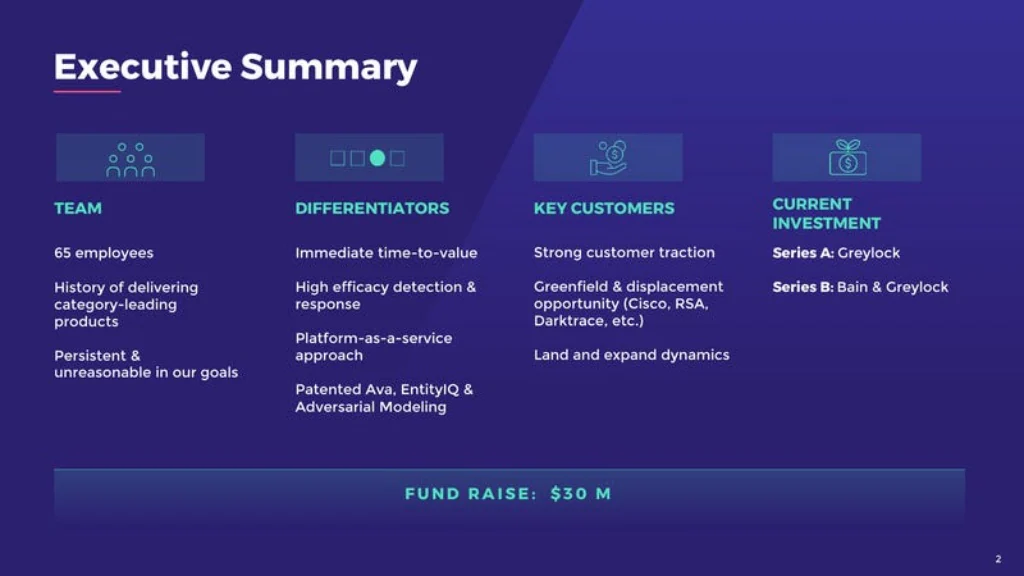
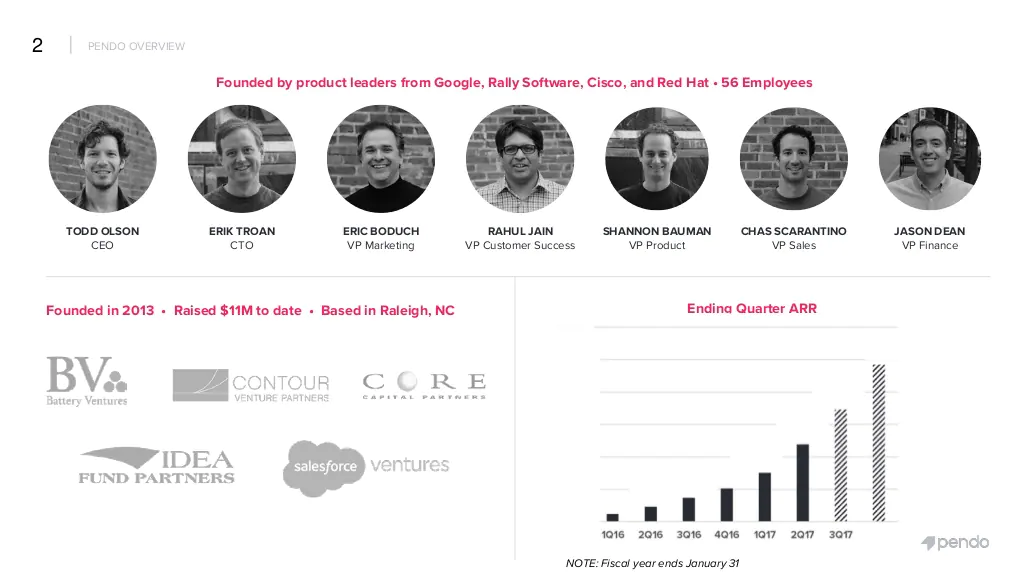
Slide #2 – Trends
With the investor’s attention now captured, it’s time to give them some context. What industry are you in? What trends are happening in that industry?
Trends are the market conditions that you have zero influence over. But, by showing how you understand them and how they impact your startup, you can demonstrate that not only is your startup inevitable, but that the risk of failure is also reduced.
Your goal with the trends slide is to show that your startup idea isn’t some crazy gamble, it’s obvious and inevitable, and that the market is about to change in a big way.
In the context of startup ideas, the important things to consider about trends are whether they are weak or strong, societal and cultural, or technological.
Weak Trends: These are usually easy to spot and include things like the aging population, increasing internet penetration rates, or a growing demand for a new product or service.
Strong Trends: These are hard to argue against. They will be big and happening quickly. They could be something like the rise of mobile payments, a technology reaching critical mass, or a new way of thinking about an old problem.
Technological Trends: These trends focus on the development of new technologies. For instance, the rise of drones, Web3, and artificial intelligence technologies are all technological trends that would be relevant to an investor pitch deck when combined with a startup idea.
Societal and Cultural Trends: These trends are about the way people are living their lives, and integrating new technologies into them. A good example of this is the trend towards health and wellness. This could be anything from the increasing popularity of mindfulness to people taking more interest in their food.
It’s important to consider societal trends alongside advances in technology, just because a technology is possible, doesn’t mean that people will want to use it (remember Google Glass?).
Building into emerging trends can lead to you raising millions without even having a pitch deck, like Hopin, or still whilst the world is in lockdown and your app is still in beta – like Clubhouse.
Examples
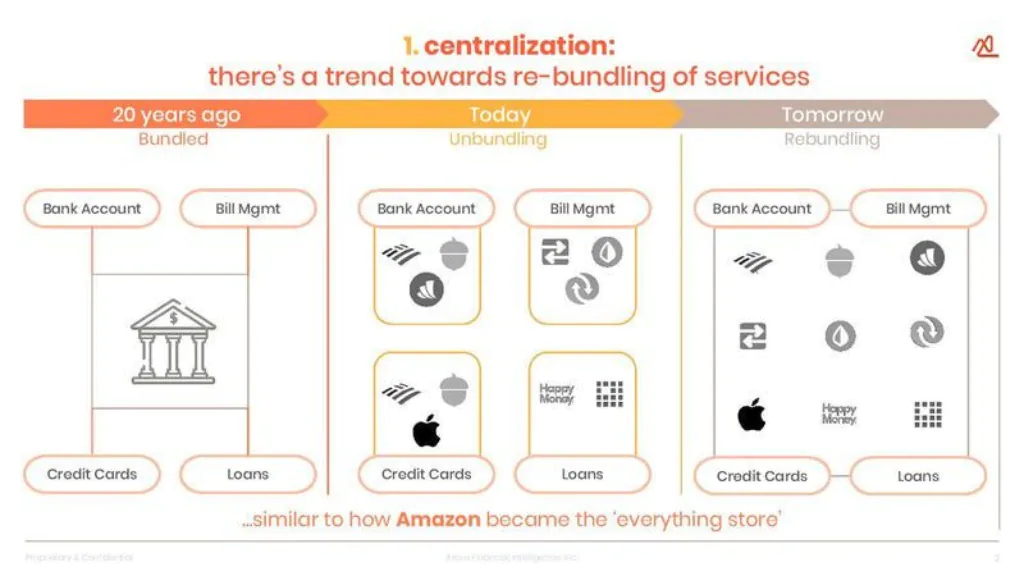
Slide #3 – Problem
Now that you’ve got the pitch deck rolling, it’s time to talk about your startup idea. What problem are you solving? What is happening right now? What are people not happy with?
When it comes to the problem slide, be specific. Don’t just say that there is a problem. Tell them what it is and make your audience feel the pain; they should be able to recall having had it themselves or easily empathise with those that do.
As a founder, you need to prove that you have a deep awareness and understanding of the problem you’re solving. You need to demonstrate that you can stand in the shoes of your customers and see the problem as they do.
Ideally, you should be able to summarise all of this into a problem statement. This is a simple one or two-sentence explanation that describes the problem, identifies the pain points, and explains why it needs solving.
Providing data to back up your problem statement is also important, but it doesn’t have to be complicated. You’re not trying to show the size of the market, just the severity of the problem.
Examples
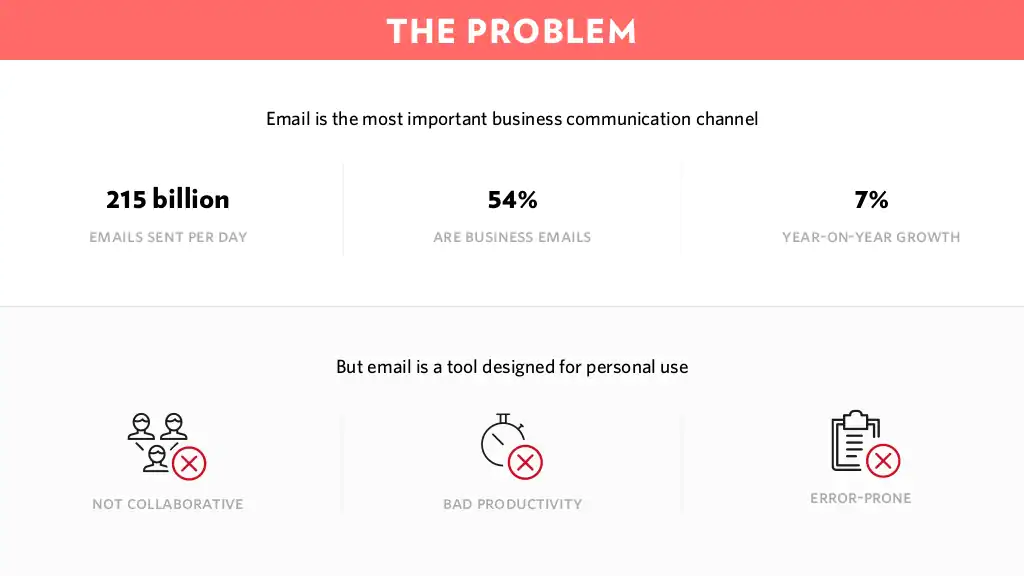
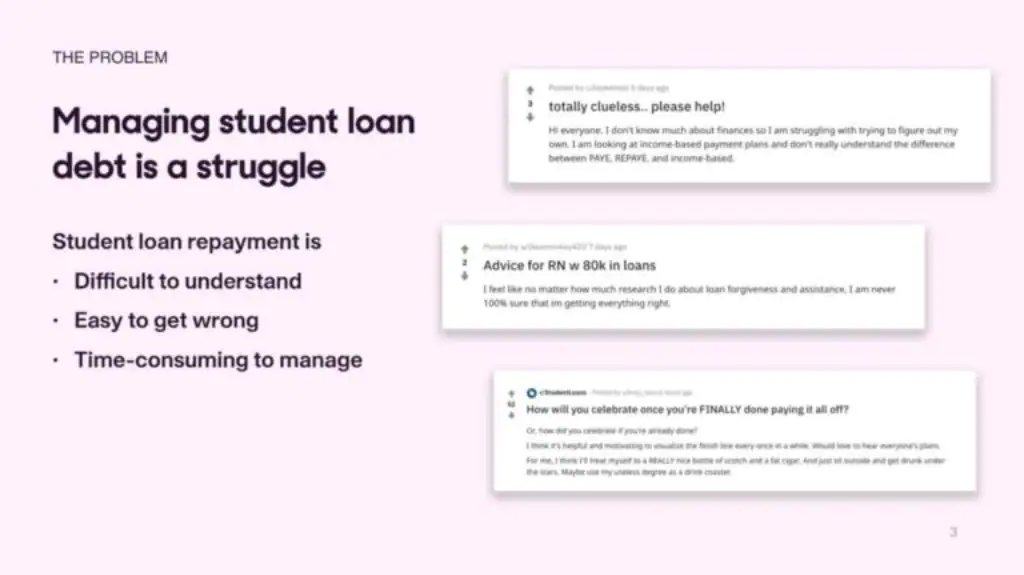
Slide #4 – Solution
Having built up an understanding of the problem, you now need to explain how you plan on solving it. What is your solution? How will your startup solve this problem? What makes your product or service different?
Your solution slide should be clear, concise, and easy to understand. You should have a brief paragraph explaining what your startup does, followed by supporting information in the form of screenshots, images, or diagrams.
Remember, during live pitching or conversations, you may be able to talk about your solution in more detail – maybe even showcase a live demo – but in your pitch deck, you need to keep it simple.
If you’re having trouble boiling down your complex solution then consider how you would sell it to a potential customer. If you can pitch it to them in a way that they understand and see the value, then your pitch deck will be able to do the same.
Examples
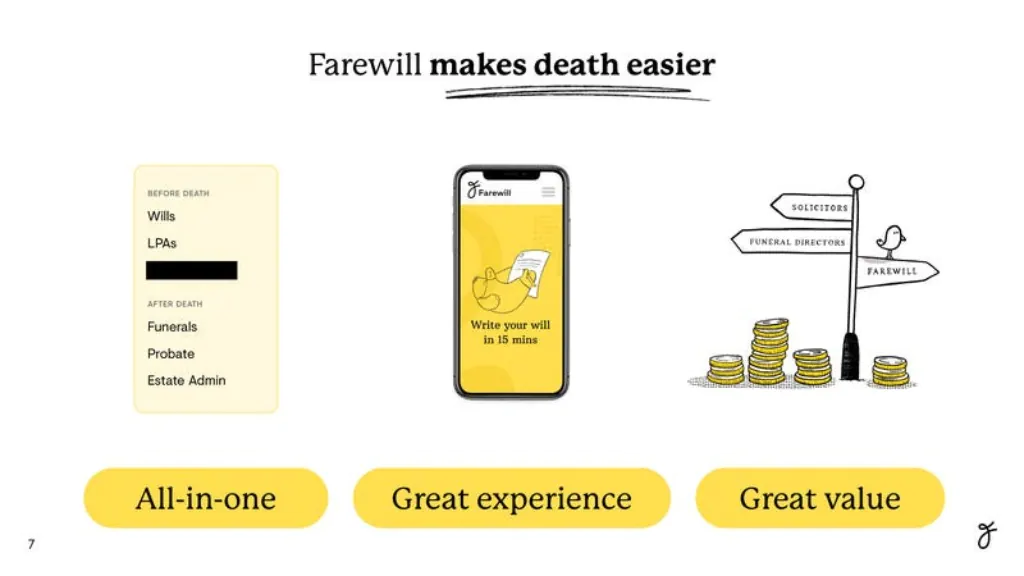
Slide #5 – Business Model
With the problem and solution explained, it’s time to move on to your business model. This is a critical slide for any pitch deck as it demonstrates how you plan to make money from your startup idea. It’s showing your investors that you understand the business side of things and that you have a plan for growth.
This slide can be a little tricky to get right, as you don’t want to overload your audience with too much information (especially at idea stage, when you don’t have a fully formed business model). However, you need to convey that the unit economics make sense and that there is a path to profitability.
There are lots of different ways to structure this slide, but the most common model breaks it down into a one-paragraph pitch of your business model, followed by one or two diagrams showing the relationships between your costs and revenue. By using simple visuals, you can convey complex ideas far more effectively than words alone.
Unfortunately, pitch decks don’t have the space to explore every aspect of your business model. It’s a good idea to create a separate document for this, which you can then share with interested investors or partners.
Examples
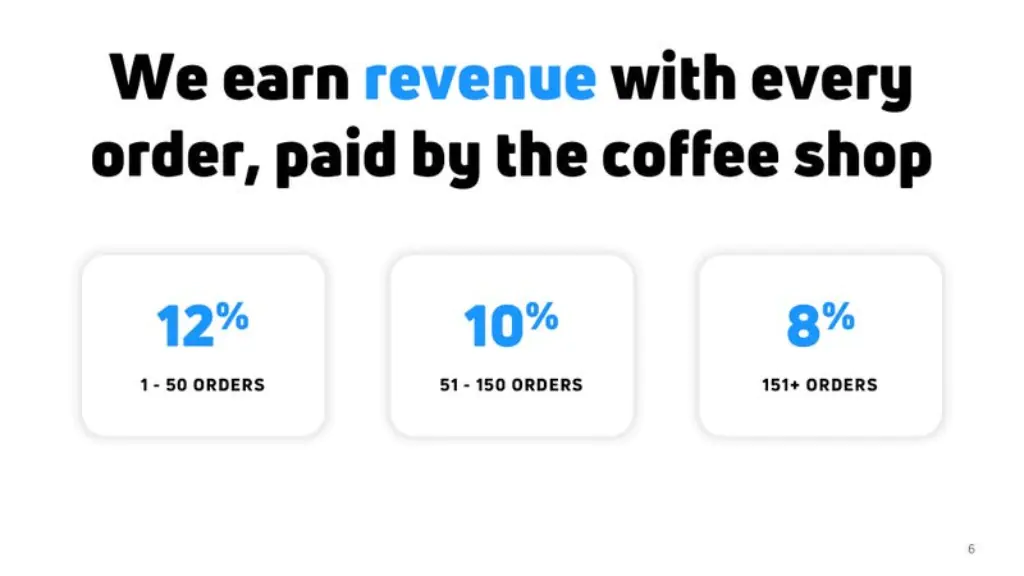
Slide #6 – Market
Now it’s time to move on to the all-important question of market size. Market sizing for early-stage startups can be a contentious issue.
Many entrepreneurs think that they need to show huge total addressable markets (TAM), and pitch themselves as the next billion-dollar startup. However, most sophisticated investors how that for most early-stage startups this is not appropriate.
Pitching a large TAM isn’t going to impress investors, they’ve seen it all before, but pitching yourself as the best company in your segment will demonstrate that you have a great understanding of your industry and the opportunity at hand.
It’s most important to be able to show that there is a market for your product or service, that it’s growing, and that there is room for you to compete. You don’t need to pitch yourself as a billion-dollar company, just pitch that you have a good understanding of the market segment, that people are spending money solving this type of problem, and that you’re going to be one of the best companies in your space.
For example, if your idea is to launch the next big analytics platform, don’t pitch a market size that includes every business in the world. Instead, focus on a specific industry or sector and show how behaviours in that industry are changing, paving the way for your product or service.
Again, you don’t need to go into too much detail in your pitch deck. A one-paragraph pitch of your market size is usually enough, followed by a simple diagram showing the trends that are opening up opportunities for your startup.
Examples
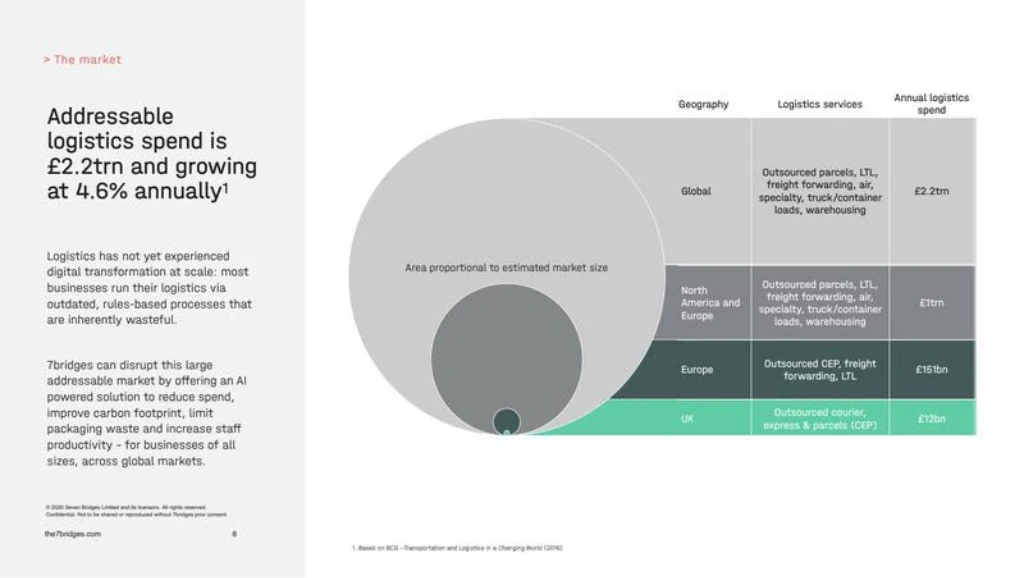
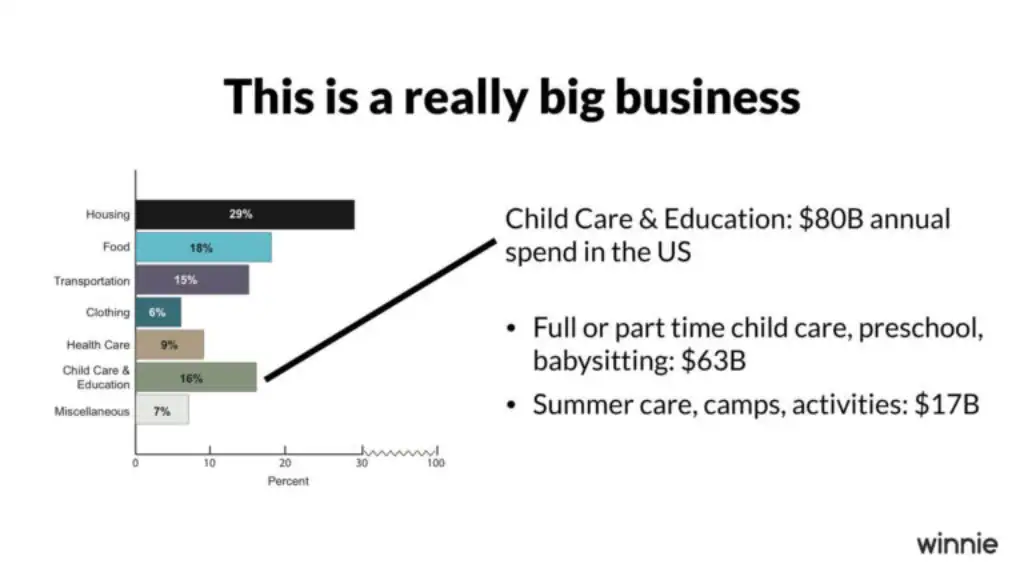
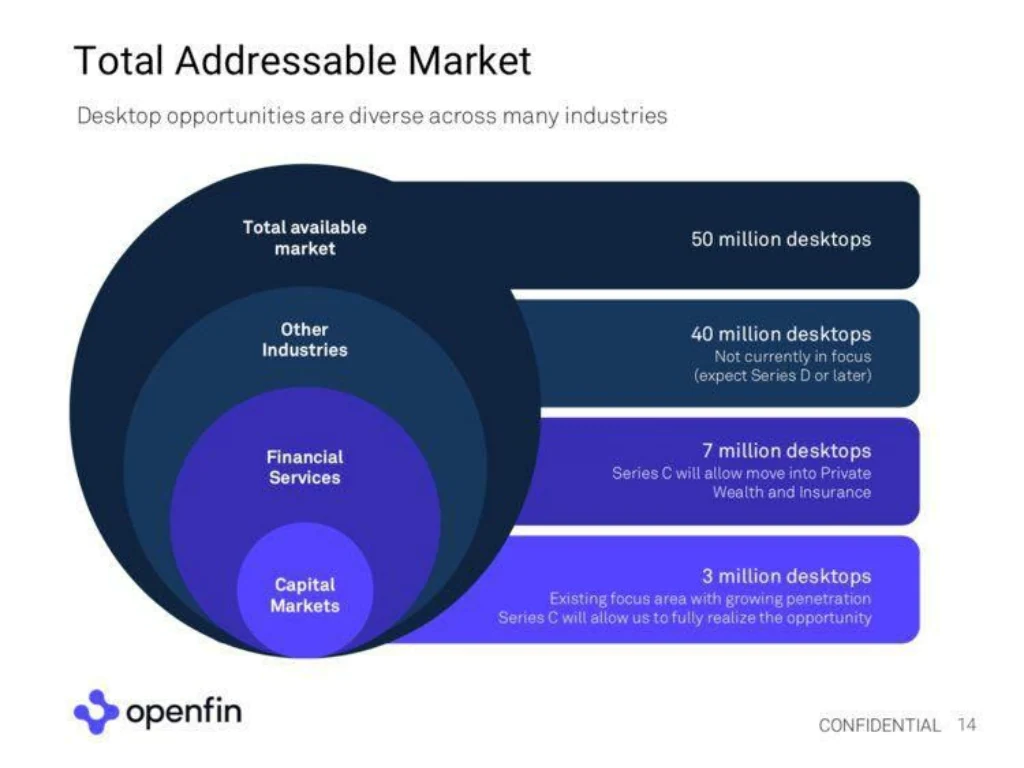
Slide #7 – Competition
This is another key slide for any pitch deck, as it demonstrates that you have done your research and that you understand the competitive landscape.
Start by defining the market segment you are targeting, and then show the key points of differentiation when compared to your primary competitors.
Describe how they fit into the customer’s perspective of the market, show where their strengths and weaknesses lie, and how you plan to compete with them.
This isn’t the place for a full analysis of your competitors, but you should be able to pitch yourself as the best company in your space, with a clear understanding of how you’re going to win.
There are two common ways to visualise your competitor analysis, the magic quadrant (or 2×2 matrix) and a comparison table.
The magic quadrant is a way of plotting your competitors on two axes, based on two factors that you’ll pluck from thin air. These visualisations are rarely credible unless you have a lot of experience in the market you are analysing, or they’ve been produced by large consultancies like Deloitte or Gartner.
On the other hand, comparison tables can be very effective as they’re easy to digest, position you alongside recognisable brands, and allow you to highlight the key differences between your company and your competitors. By comparing factors that are demonstrably important to customers, you’ll come across as more credible and able to back up your pitch with cold, hard facts.
Examples
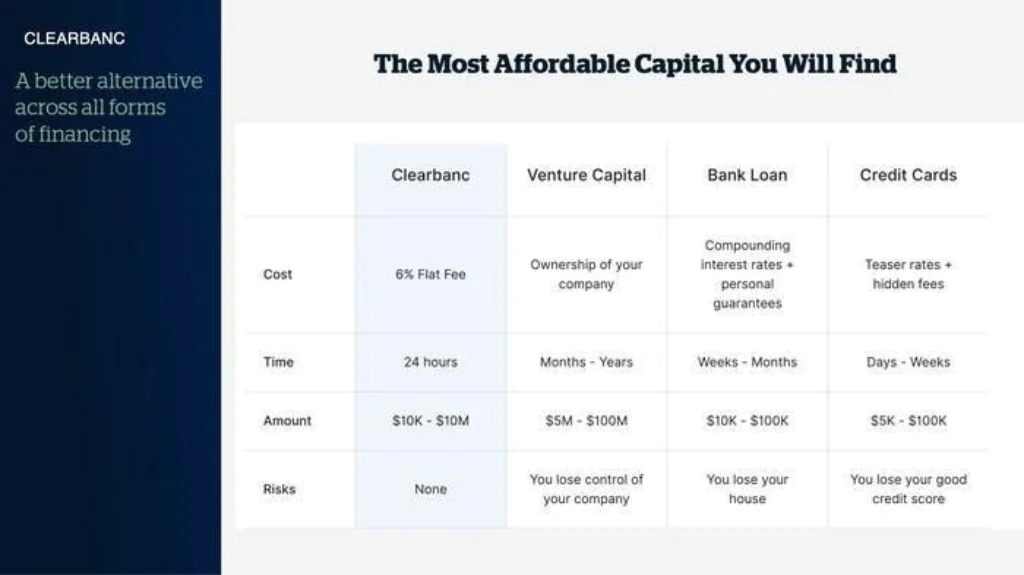
Slide #8 – Go to Market
Now it’s time to talk about marketing and sales strategy, or how you’re going to get your product or service in front of customers. This is where you’ll pitch your go-to-market strategy. Your go-to-market slide should include the following elements:
- The channels you will use to reach your target audience
- The actions you will take to put your product in front of potential customers
- The milestones you will hit as you progress through your go-to-market plan
- The resources you will require to reach your target successfully
Start by describing your target market and how you plan to reach them. This might include explaining your distribution channels, sales strategy, or marketing approach. You can also use this slide to talk about any partnerships you have in place, or how you plan to leverage them.
Next, explain the actions you will take to reach your target audience, and how you plan to measure success. These actions should fit within each of the channels that you’ve already identified. For example, if you’re using digital marketing, your actions might be things like website development, SEO, or social media campaigns.
Lastly, list the key milestones you will hit as you progress through your go-to-market plan, and identify the resources you will require to achieve them. You can include your team, budget for marketing activities, or specific assets like signage.
Examples
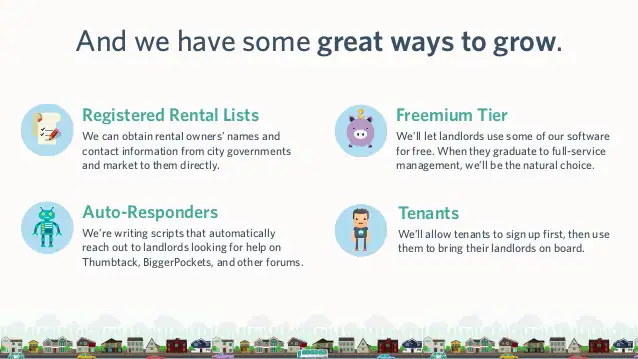
Slide #9 – Traction
As a startup, traction is key. Investors want to see that you’re making progress and that your product is resonating with customers. This slide is often one of the trickiest for startups at idea-stage, as it can be difficult to show commercial progress and it will be too early for product-market fit.
There are a few different ways to pitch traction, and you need to choose the one that works best with your company and the stage you’re at. Some options include user base, revenue growth, or market validation.
User Base
If you’re focusing on your user base, you’ll want to pitch a clear and compelling story about your customer base. If you have a small data set, it’s worth showcasing your first 100 customers as this makes the numbers seem more real.
If you have a large customer base, pitch your exponential growth in terms of percentage or absolute figures. For example, pitch how many customers you signed in the past quarter or year.
Revenue Growth
If you’re focusing on revenue growth, pitch your current (or projected) sales figures. You can also pitch the average ticket size or value of your deals. Alternatively, pitch your revenue growth (in terms of percentage or absolute figures) over the past year.
Market Validation
If your product is still at idea-stage and still has a long way to go before it’s ready for market, pitch your progress in terms of real-world validation. For example, pitch the number of people who have registered to use your product or service, or pitch the number of companies that have expressed interest during interviews.
Most importantly, be honest about your progress. If they are interested, investors will dig into your traction claims and you’ll need to back them up with data – if it turns out that you’ve lied or embellished the facts, you’ll not only lose trust and credibility, you’ll probably lose the investment too.
Examples
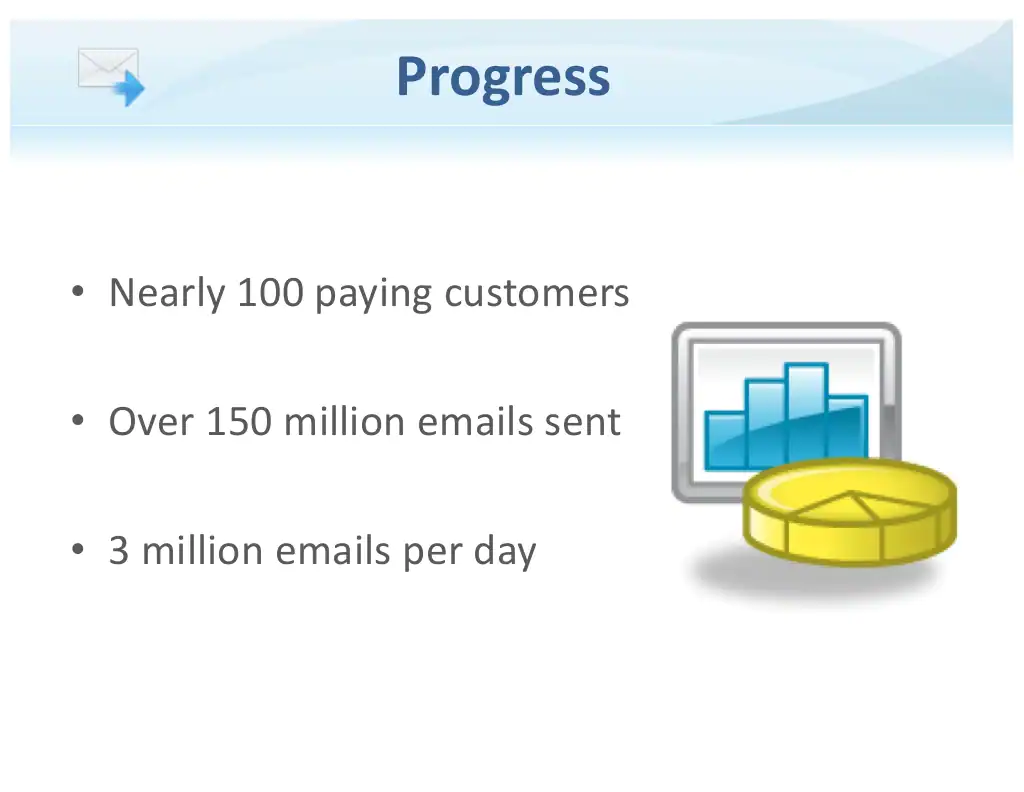
Slide #10 – Team
Having set the scene in which your startup operates, it’s time to introduce the management team behind your startup. Investors will be keen to learn about who is leading your company and how they will transform your idea into a profitable business.
The focus here must be you and your co-founders. People invest in people, so you’ll need to show how you have the vision, experience, and motivation required to deliver on your pitch.
Keep your team slide short and sweet. You’ll want to include the founding team, highlighting their relevant experience in the industry or field that you’re operating within.
Pictures help to make your presentation more personal, so make sure you have a good quality headshot of each team member, consistently formatted so that everyone appears the same size and in focus.
The team slide should only include the founding team, though it is acceptable to include key team members, as well as notable advisors or investors if beneficial. If you do this, ensure that there is a clear visual separation between the two groups.
Examples

Slide #11 – Investment Proposal (The Ask!)
This is the big one. The pitch deck wouldn’t be complete without a clear proposal of what you’re asking for from your investors. This slide should clearly state the amount of money you’re seeking, as well as what you plan to do with it.
It’s important to remember that investors are looking for a return on their investment (ROI), so your proposal must be realistic and demonstrate how you will use the funds raised to reach key growth milestones.
To convince investors, your “Ask slide” will need to answer these three questions:
- How much are you seeking to raise?
- What will you do with the money?
- What do you intend to accomplish with the funds?
Always remember to pitch the ask in terms of how it benefits the investor – not just you. For example, if you’re seeking a £100,000 investment, explain how that money will help you reach a specific milestone that will create value for your investors.
Be specific about how much you need to raise, and where you plan to deploy the money. This will show that you’ve done your homework and understand how you will grow your business.
A simple pie chart with the breakdown of how you plan to use funds can go a long way towards demonstrating to investors that you’re serious about using their money wisely. For example, if 25 percent goes towards marketing spend, 30 percent for technology development, and 45 percent for new hires, that’s a good indication you have your priorities straight.
It’s unlikely that you will be profitable before the next round of funding, but it is usually worth highlighting the key numbers from your financial projections to give investors an idea of the scale and trajectory of your business.
Perhaps the most important factor in your investment ask is demonstrating that you understand how much capital you require to hit key growth milestones without requiring further funding rounds for at least 12-18 months. This is something that almost every investor will expect you to have a solid plan for.
Examples
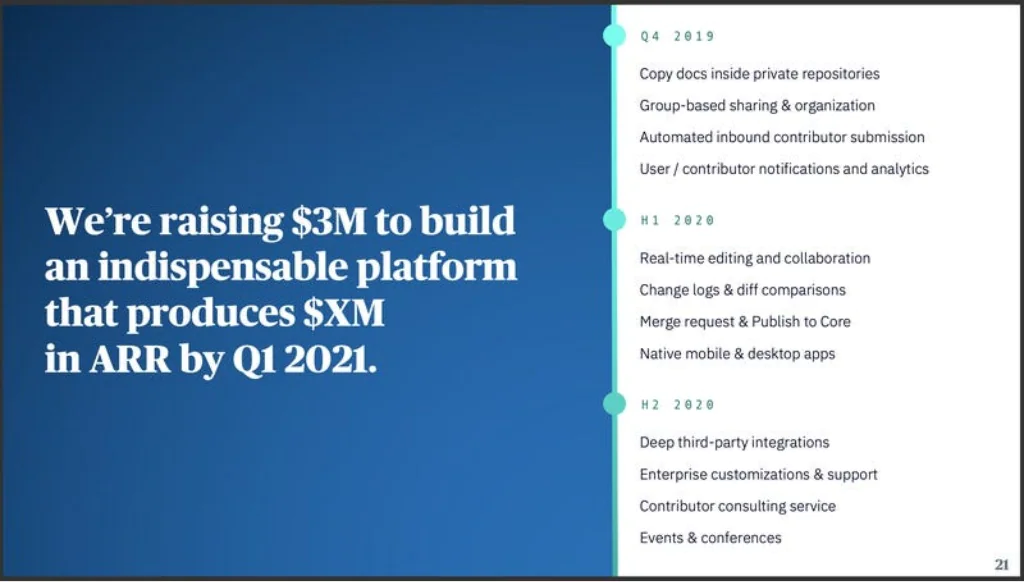
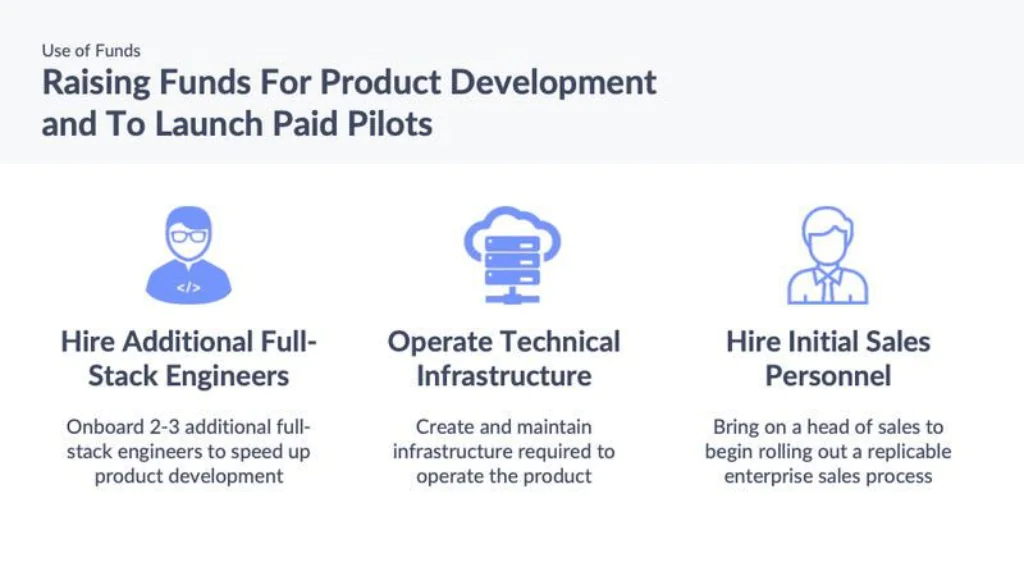
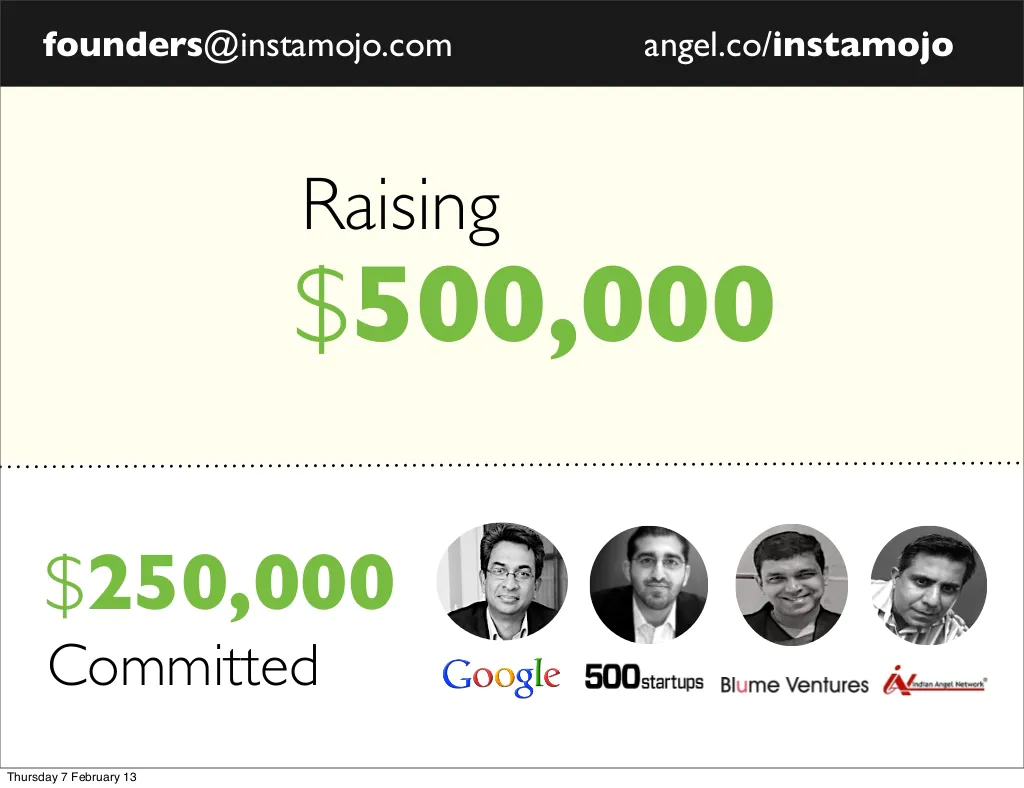
Pitch Deck Design
Whether you’re sharing your deck by email or presenting on stage, the design of your pitch deck matters. However, you can’t afford to hire a professional pitch deck designer to help. So, what do you do?
KEEP. IT. SIMPLE.
Your pitch deck is not the place to show off your design skills – or highlight any lack of expertise in this department! The only goal of your pitch deck is to communicate information clearly and concisely so that investors understand what you’re pitching and can get excited about it.
Keep your presentation simple, use bold typography, highlight key information, and stick to a maximum of two or three colors. Resist the urge to use lots of graphics and animations, as these can be distracting and take up valuable space on your slides.
How to design a better pitch deck
There are a lot of things to consider when designing your pitch deck presentation. Below are some tips on how to make your pitch more effective:
Keep it simple
The average investor has a short attention span, so keep your deck concise and easy to follow. Use clear language, avoid complex graphs and charts, and stick to a maximum of 15 slides.
Stick to a consistent layout
Use the same fonts, colors, and layouts throughout your pitch deck to create a cohesive look.
Make it easy to read
Slides that are crowded with text and images will be difficult for your audience to read and comprehend.
Use a pitch deck template
A pitch deck template is a great way to ensure that your pitch deck looks professional and follows the proper design guidelines.
Pitch deck design tools
Today, there is a huge selection of online design tools and no-code builders to help you build your perfect deck. Below are just a few of the design platforms that can help you craft your pitch.
Slidebean
An easy-to-use platform that allows startups to build a beautiful slide deck without any special design skills. Start from scratch or create your slides using predefined pitch deck templates.
Canva
Offers a wide range of design tools and templates for creating professional pitch decks. The free version includes limited features, while the paid plans start at $12/month.
Beautiful.ai
This pitch deck design app is great for startups and entrepreneurs who need to create a pitch deck quickly. The basic plan starts at $12/month (billed annually) but there is a 14-day free trial.
Pitch
The tools provided by Pitch allow you to quickly produce a high-quality pitch. Even if you’re not a designer, you can create a strong pitch deck that looks great. The basic plan is free, but you’ll need to upgrade to the paid plans for more features.
While these design tools can be extremely powerful, it still pays to follow the same basic guidelines to ensure that your pitch deck is easy for investors to understand; Keep it simple, avoid animation, stick to a consistent layout, and make sure your text and images are easy to read.
Key takeaways
When you’re trying to capture investors’ attention and raise equity funding, you need to show them that you have a good plan. But startups aren’t traditional businesses and they don’t use traditional business plans.
like the Holy Grail, the business plan remains largely unattainable and mythological. Most experts wouldn’t agree, but a business plan is of limited usefulness for a startup because entrepreneurs base so much of their plans on assumptions, “visions,” and unknowns.
Guy Kawasaki
This is why pitch decks are the perfect approach to sharing a startup business plan.
Fundamentally, your pitch deck is used to share your vision, attract investors, and start conversations. As a founder, you should be prepared for investors who may not “get” your pitch deck right away — this doesn’t mean that they aren’t interested in what you’re doing.
Be prepared to answer questions and have an engaging conversation about your startup. Investors want to see that you have a clear understanding of your business, the problem you’re solving, and how you plan on making money. They also want to know that you’re capable of executing your vision.
Remember, pitch decks are just one part of the overall investment process. If you’re able to create a pitch deck that effectively communicates your idea and leaves investors wanting more, then you’re on the right track!
